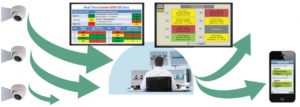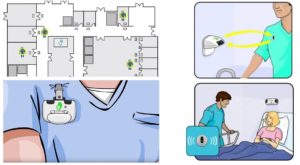Summary of the different concepts of ECM
In our previous posts, we demonstrated that direct observation of hand hygiene is labor-intensive, time-consuming and expensive. Electronic monitoring systems (ECM) can eliminate the shortcomings of the direct observation. Now, we summarize the different concepts of ECM.
Video-monitored, direct observation
These systems, like Arrowsight, provide remote video auditing service. In this case, the observer is not present in the ward, but sitting in a monitoring center. The observation this way becomes more convenient and requires less human resource. These systems are not automated, rather technology-supported, as data is always processed by a human observer. Main question related to these systems is privacy; if we want to monitor every hand hygiene moment, then the whole patient care process should be recorded and sent to a third-party monitoring center, and the evaluation is still relying on their personal judgement.

Figure 1: Video-monitored direct observation, Arrowsight’s concept.
Electronic dispenser counters
Most of today’s solutions are based on this concept. Health-care workers (HCW) wear badges (SwipeSense, MedSense, CloudClean) or wrist bands (Vitalacy, FirstHand), which enable to monitor their locations. Dispensers are also equipped with special devices that can record dispenser use. These systems collect the data and analyze weather dispensers were used each time a HCW enters or exits a patients’ room. Main limitation of these systems is that the event of entering and exiting patients’ room are only two out of the 5 moments of hand hygiene. These systems have difficulties in recognizing the other three moments (aseptic procedure, body fluid exposure, touching patient surroundings). Another doubt is HCW should not wear a watch or any bandwritst, as it can help the spread of the infections. This holds major challenges even in the case of employing antimicrobial materials.
 Figure 2: Electronic dispenser counters: A: SwipeSense, B: MedSense, C: Vitalacy
Figure 2: Electronic dispenser counters: A: SwipeSense, B: MedSense, C: Vitalacy
Alcohol sensors
Some systems, like BioVigil and HyGreen use alcohol sensors. When entering, or exiting the patients’ room the worker’s badge vibrates, as a reminder function to perform hand hygiene. The system can sense the alcohol on health-care worker’s hands after that. If alcohol is present when indicated, badges turn green. Therefore, workers and patients also get a feedback about hand hygiene compliance. These systems have the same limitation: they are only great in monitoring Moment 1 and 4 (entering and exiting the room), and they are not specific for checking the alcohol in the hands.
 Figure 3: System uses alcohol sensor; A: Biovigil, B: HyGreen
Figure 3: System uses alcohol sensor; A: Biovigil, B: HyGreen
Monitoring hand hygiene technique
The above-mentioned systems are able to monitor event compliance, but not the quality of hand hygiene. Park et al 2014 investigated hand hygiene event compliance and also hand surface coverage. They found, that overall hand hygiene compliance (event compliance) was quite high (86.7%), yet, hand surface coverage was inadequate for over 90% of all the health-care workers [1]. Even perfect event-based compliance cannot guarantee to prevent the spread of health-care associated infections. It is also necessary to monitor the quality of the hand hygiene.
There are only two systems that are focusing on hand hygiene technique: SureWash and Semmelweis Scanner. The SureWash system records the hand movements during hand hygiene with a video-camera, and analyses the process. It can help to train the WHO 6-step hand hygiene protocol, and may only ensure that all the steps were implemented. Semmelweis Scanner focuses on the overall outcome; it uses an automated fluorescent method to examine whether the whole hand surface is covered properly with a UV-dye containing handrub.
Conclusion
There are several solutions for monitoring hand hygiene event compliance. This is a complex and hard domain, shown by the fact that many promising technologies emerge and then disappear from the clinics. Event monitoring is not providing data about the quality of hand hygiene, and without it cannot guarantee that hands are really disinfected after a hand hygiene event. There are only two solutions that can monitor hand hygiene technique, and only the Semmelweis Scanner examines the result of the hand hygiene.
Read our previous post about the shorcomings of direct observation. Please stand by for our next blog entry on the usability of electronic compliance monitoring systems.